|
Turmeric (Curcuma longa Lin.)
Zingiberaceae
Varieties
Co 1, BSR 1, Roma, Swarna, Sudarshana, Suguna, Sugandham, BSR 2, Ranga, Rashmi, Rajendra Sonia, Krishna, Suroma, Allepy finger turmeric (AFT), IISR Prabha, IISR Prathiba, IISR Alleppey Supreme and IISR Kedaram.
Local cultivar: Salem and Erode
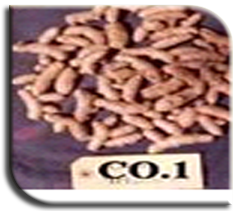 |
 |
| Co 1 |
BSR 1 |
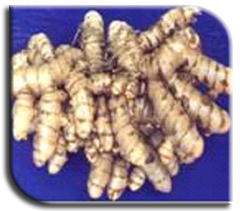 |
| BSR 2 |
Soil and climate
A friable well drained red loamy soil in wet or garden lands under tropical conditions is ideal. It can be grown in regions receiving an annual rainfall of 1500 m.
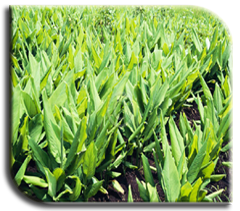 |
 |
| Turmeric Field |
Turmeric Flower |
Season
May-June is suitable
Seed Treatment
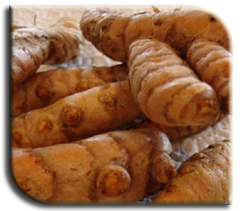 |
| Finger rhizomes |
Propagation
Mother rhizome & finger rhizomes. Seed rate of finger rhizome - 2000kg/ha.
Main Field Preparation:
Main field is ploughed four times with chisel and disc plough each one time and cultivator twice. Ridges and furrows are formed at spacing of 45 cm (or) raised beds of 120 cm width are formed at an interval of 30 cm and the laterals are placed at the centre of each bed. The beds are wetted for 8-12 hours through drip irrigation depending upon soil moisture level.
Spacing
45 x 15 cm. 25-30 g weight rhizomes are to be dibbled at a depth of 4 cm.
Manures and manuring
Basal: FYM - 25 t /ha, neem or groundnut cake - 200 kg/ha, 25:60:108 kg of NPK per ha; 30 kg of FeSO4 and 15 kg of ZnSO4, 10 kg in each of Azospirillum and Phosphobacteria per ha to be applied at the time of planting.
Top dressing: 25: 108 kg of N and K/ha applied on 30, 60, 90, 120 and 150 days after planting.
Micronutrient application
Apply 375 g each of Boron, Iron and Zinc, at rhizome development stage, as Borax, Ferrous sulphate, Zinc sulphate + 375 g of Urea in 250 lit of water/ha. Spray twice at 25 days interval.
The above micronutrients are dissolved in Super phosphate slurry (15 kg Super Phosphate is dissolved in 25 lit of water stored overnight and the supernatant solution is made upto 250 lit). In this solution, the micronutrients are added.
Fertigation:
Fertigation is done as per the recommended dose with 150:60:108 kg of NPK/ha and is applied throughout the cropping period once in three days.
75 % of the recommended dose of phosphorous is applied as basal dose. Water soluble fertilizers like 19:19:19, Mono ammonium phosphate (12:61:0), Multi K (13:0:45) and urea are used.
Fertigation schedule for turmeric
| Crop Stage |
Duration (in days) |
Nutrients requirement (%) |
Quantity applied (kg/ha) |
Planting to
establishment stage |
15 |
10 |
20 |
10 |
19:19:19
Multi K
Urea |
15.78
17.33
21.20 |
Vegetative stage |
60 |
40 |
30 |
20 |
19:19:19
Multi K
Urea |
9.83
96.00
100.57 |
Rhizome initiation
stage |
60 |
30 |
30 |
30 |
19:19:19
Multi K
Urea |
4.91
71.28
76.29 |
Rhizome maturation stage |
135 |
20 |
20 |
40 |
19:19:19
Multi K
Urea |
15.78
40.42
47.06 |
Total Duration |
270 |
100 |
100 |
100 |
|
|
Intercultivation
Onion, Coriander and Fenugreek can be planted as intercrop on the sides of the ridges 10 cm apart (250 kg seed Onion/ha). Redgram and Castor can also be planted at wider spacing. Weeding can be done as and when necessary. The plants are earthed up at the time of 2nd and 4th top dressings.
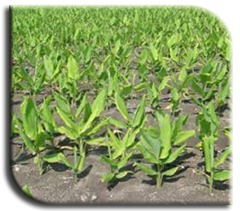 |
| Drip irrigation in turmeric |
Intercropping
 |
 |
 |
| Turmeric + chilli |
Turmeric + onion |
Turmeric + onion + bhendi |
Plant protection
Pre planting treatment
The seed rhizomes are dipped in Carbendazim 1 g/lit and Phosalone 35 EC 2 ml/lit for controlling rhizome rot and scales.
Pests
Thrips
Thrips can be controlled by spraying Dimethoate 30 EC or Methyl demeton 25 EC 2 ml/litre.
Rhizome scale
Rhizome scale can be controlled by applying well rotten sheep manure @ 10 t/ha in two splits (once basally and other at earthing up) or Poultry manure in 2 splits followed by drenching Dimethoate 30 EC 2 ml/lit or Phosalone 35 EC 2 ml/lit.
Nematode
Avoid planting turmeric after Banana or other solanaceous vegetables. Plant only after taking suitable control measures. Apply Carbofuran 4 kg a.i./ha twice on the third and fifth month after planting the rhizomes.
Diseases
Rhizome rot
- Treat the seed rhizomes with 0.3% Copper oxychloride for 30 min or Drench with Bordeaux mixture 1 % or Copper oxychloride 0.25 % or Ridomil 0.1 % or
- Seed treatment with P. fluorescens 10 g/kg and T. viride 4 g/ Kg and soil application of 2.5 Kg/ha each of P. fluorescens and T. viride in 50 kg of FYM as basal and top dressing on 150 Days after planting.
Leaf spot
Leaf spot can be controlled by spraying Carbendazim 500 g/ha or Mancozeb 1 kg/ha or Copper oxychloride 1.25 kg/ha.
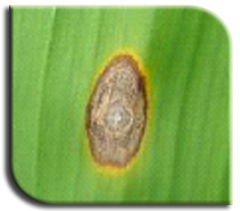 |
| Leaf spot |
Leaf blotch
Leaf spot controlled by spraying Carbendazim 500 g/ ha or Mancozeb 1kg/ha or Copper oxy chloride 1.25 kg/ha. Mix sticker solution @ 5ml / 10 litre of spray solution
 |
Leaf blotch |
Harvest
The plants will start lodging, yellowing and drying on crop maturity. The rhizomes are dug with spade or digging forks.
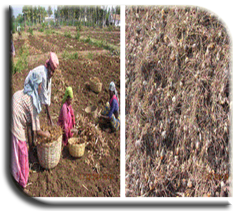 |
| Harvesting and cleaning of harvested rhizomes |
Yield
Fresh rhizomes : 25-30 t/ha
Cured rhizomes : 5-6 t/ha
Storage of seed rhizomes
Seed rhizomes can be stored in open sand media with a partially closed pandal.
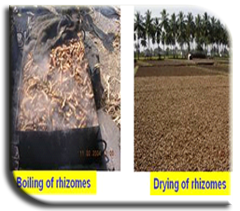 |
| Processing of rhizomes |
Market information
| Growing Districts |
Karur, Villupuram, Coimbatore, Salem, Dharmapuri, Krishnagiri, Erode |
| Major markets in Tamil Nadu |
Erode, Karur, Coimbatore, Salem and Dharmapuri |
| Preferred varieties |
Erode local, BSR, Salem variety |
| Grade specification |
Bright Yellow colour, size above 3cm length, hard, when broken gives metal sound , smooth skin , without impurities |
|














